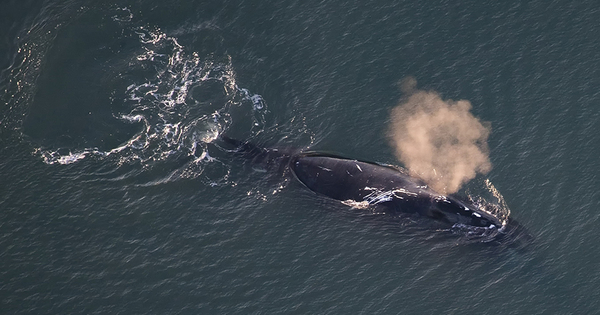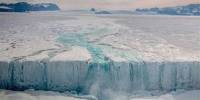The annual migration of bowhead whales between the Bering and Beaufort Seas is a conservation success story, with current numbers approaching – if not exceeding—pre-commercial whaling levels. However, climate change is altering the whales’ feeding sites and migration patterns, perhaps forcing them to spend more time in the paths of approaching ships, according to a recent study.
More than a decade of acoustic data was utilized by researchers to track bowhead whale migrations between their regular overwintering sites in the Bering Sea and summer feeding grounds in the Chukchi and Beaufort Seas. According to acoustic data, the whales left the summer feeding grounds around six weeks later in 2022 than in 2008.
Some are also spending winter farther north in the Chukchi Sea, where commercial traffic in particular has been increasing. That means they could be lingering longer in shipping lanes, which grow busier as sea ice shrinks.
“A shift like this may not necessarily be a bad thing for the whales, but any time we see more overlap with whales and shipping traffic, we should be concerned,” said Angela Szesciorka, a marine scientist at Oregon State University’s Marine Mammal Institute who led the study. “There will be winners and losers, but only time will tell.”
The study was published in Geophysical Research Letters, which publishes high-impact, short-format reports with immediate implications spanning all Earth and space sciences.
A shift like this may not necessarily be a bad thing for the whales, but any time we see more overlap with whales and shipping traffic, we should be concerned. There will be winners and losers, but only time will tell.
Angela Szesciorka
Whales on the move
Historically, the bowhead whale population studied by Szesciorka wintered in the Bering Sea. In April, they’d go north via the Chukchi Sea and into the Beaufort Sea off the shores of Canada and Alaska, then west to the Russian Chukotka Peninsula before returning south about mid-November. During the 2008-2009 International Polar Year, researchers installed an underwater microphone known as a hydrophone on the Chukchi Plateau for the first time and were shocked to hear bowhead whales in late spring and summer, far north of their previously known migration paths.
Traditional knowledge in Indigenous Arctic communities suggests that the whales’ migration patterns have changed in recent years, and data from a small number of satellite-tagged whales supports this. As temperatures rise and sea ice shrinks, the entire Arctic ecosystem, from small plankton and krill to whales, is pushed to adapt. Scientists suspected if climate change was behind the shift in bowhead whale migration patterns, but they required additional data on the whales’ migration habits throughout time to figure it out.
Szesciorka and her coauthors have previously tracked bowhead whale movements through the Bering Strait using hydrophone recordings. From 2008 to 2022, they monitored bowhead whales in the western Beaufort Sea and Chukchi Plateau using hydrophones.
“Bowhead whales are highly vocal,” Szesciorka said. “Males sing pretty much twenty-four-seven from fall through spring, so you know when they’re there.”

The recordings revealed that the whales shifted their winter departure time from the western Beaufort Sea 45 days later in 2022 than they had in 2008. They also spent more time in the summer in the Chukchi Sea, and some appeared to entirely forgo migrating back to the Bering Sea as they normally would.
Some of these changes are most likely due to increased food availability in the Chukchi Sea as a result of warmer waters and declining sea ice, the study suggests. But scientists will need to do more research to know for sure.
“The changes we are seeing in migration patterns lead to many questions,” Szesciorka said. “How many whales are going to the Chukchi Sea in the summer? What are they feeding on? Do the same individuals return each year? We’re essentially learning on the fly how whales are responding to changing climate.”
There’s also concern that Indigenous harvests of bowhead whale could be impacted. Bowhead whales could end up abandoning parts of their historic ranges, leaving some tribes with no access to this traditional food and cultural resource. Having tribal involvement in whale management is critical, Szesciorka said.
Seasonal shifts and ship strikes
Spending more time up north, where commercial maritime traffic is increasing as sea-ice extent decreases, may put whales at risk of dangerous contacts with vessels.
“With this general northward shift paired with an increase in vessels and shipping, the threat of ship strikes will probably increase,” she said. Shipping in the western Chukchi Sea has increased by roughly 13% since 2009, but there hasn’t been an increase in bowhead ship strikes “that we know of,” she said. Ship strikes can only be proven during harvests; other whales may die and wash up unnoticed.
But Szesciorka sees opportunity.
“Right now, the Arctic is kind of the wild west,” she said. “As sea ice continues to decline, shipping, especially large commercial vessels that go much faster than smaller fishing boats, is only going to increase. It’s better to start thinking about this sooner rather than later so we can prevent problems rather than try to respond to them.” One solution would be to establish speed limits in bowhead whale seasonal habitat, reducing the risk of ship strikes and noise pollution, she said.
The yearly movements of bowhead whales are shifting swiftly, in tandem with other rapid changes in the Arctic. But this isn’t necessarily a bad thing. Szesciorka speculated that the whales may be adaptable enough to cope with the changes.
“We saw these changes in migration patterns in just nine years,” she went on to say. “For a species that may live to 200, it’s rather stark. This demonstrates their ability to adjust to new environments for the time being. But will they eventually be unable to adapt? We need to wait and see.”
















